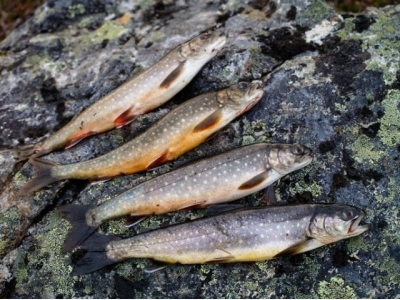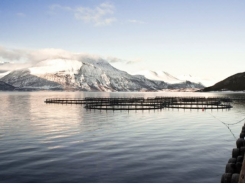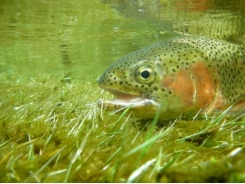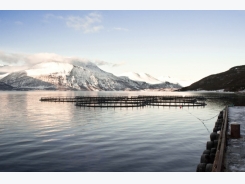Yeast digestibility hinders effectiveness of novel protein based fish feed

Research, just published, evaluating a mussel and yeast based feed for Arctic charr found it restricted fish growth.
The feed comprised of sprat and herring, blue mussels and baker's yeast, in a ratio of three parts to the whole.
Fish fed with this feed grew 11.5% less than the control group, said the Swedish researchers, writing in Aquaculture.
The team said the likely reason for the growth limitations was the digestibility of the yeast.
“The digestibility and microscopy analysis of the faeces suggested a lower digestibility of the test feed, presumably caused by the fish's inability to utilize the nutrients from the yeast cells.”
On a positive note, they said consumers' perceptions of the final product were evaluated through a sensory evaluation, indicating no differences in scores of fillet quality between the two treatments.
The authors stressed that in order to increase feed and fish production as well as reduce and mitigate the negative impacts on the environment of such production, it is important to use products that do not compete with human food interests.
“However, using new ingredients in fish feeds warrants careful evaluation of a wide range of mixtures, components, and treatments in different environmental conditions and responses of the fish to these.”
Background
The team said they wanted to investigate the potential of a possible niche production of Arctic charr through the usage of local ingredients in the fish feed, mainly derived from the Baltic Sea area and of minor value for direct human consumption.
In Sweden, the researchers noted Arctic charr are often farmed in net pens situated in hydropower dam reservoirs (Eriksson et al., 2010). The said the inclusion of protein sources originating from the Baltic Sea for those farms could potentially create a nutrient loop through the uptake and transport of nutrients from eutrophicated to oligotrophicated waters through fish feed (Eriksson et al., 2010).
“All ingredients are protein sources that are currently considered unattractive for human food production. Arctic charr is an extreme cold-water species and can grow in low temperatures (Brännäs and Wiklund, 1992), therefore it is of importance to investigate their response to new feeds also in low temperatures.”
Blue mussel farms have been trialled in the Baltic Sea to evaluate their function as cleaners of eutrophicated water bodies (Lindahl et al., 2005 ; Olofsson et al., 2013), said the researchers. “The mussels are excellent nutrient assimilators, but due to the low salinity in the Baltic Sea, they never reach full size (Schütz, 1964) and are therefore not attractive to the markets. Furthermore, blue mussels are an unused resource in the Baltic Sea and has a favorable amino acid profile (Langeland et al., 2016), as well as a fat composition suitable for salmonids (Berge and Austreng, 1989). Mussels have also been suggested to increase palatability of the feed for some fish (Mackie et al., 1980).”
They also noted that fatty fish from the Baltic Sea such as sprat and herring contain high levels of undesirable environmental contaminants such as polychlorinated biphenyls (PCB) and dioxins that make them unattractive for human consumption (Isosaari et al., 2006).
“Nevertheless, these toxic compounds can be separated from both the fishmeal and oil through an inexpensive industrial process, rendering them usable for fish feed (Oterhals and Nygård, 2008; Sprague et al., 2010).”
Moreover, they said Baker's yeast has a high growth rate and can grow on several substrates such as waste biomass, which contributes to recycling of nutrients and may lower amounts of waste (Gélinas and Barrette, 2007; Matassa et al., 2015).
“Yeast is of great interest as an alternative protein source to fishmeal (Omar et al., 2012; Rumsey et al., 1991; Øverland et al., 2013a). However, the high nucleic acid (NA) levels in yeast limits its use as a major protein source for most farmed terrestrial animals. Because fish exhibit higher liver uricase activity than terrestrial animals, they can metabolize higher levels of NA than terrestrial animals (Kinsella et al., 1985), and Arctic charr have responded well in terms of growth and digestibility when fed diets with intact baker's yeast (Vidakovic et al., 2016).”
Method
In that context, the researchers said they developed a feed mixture called ‘Baltic blend’ (Kiessling, 2013) containing one third of each: Baltic Sea blue mussels (Mytilus edulis), Baltic Sea fishmeal derived from two pelagic fish; sprat (Sprattus sprattus) and herring (Clupea harengus), and baker's yeast (Saccharomyces cerevisiae) for the salmonid, Arctic charr (Salvelinus alpinus L.).
They conducted a ten-month trial in a farm setting, where they tested the response of Arctic charr to the ‘Baltic blend’ by measuring growth responses of the fish and feed digestibility along with microscopy analysis of feces. The team said they used a fishmeal-based feed mirroring a commercial type Arctic charr feed as a control.
The researchers also evaluated consumers' opinion about the fillet quality using sensory evaluation.
Results
The findings showed that all fish reached a market size (500–1000 g) at which Arctic charr are commonly slaughtered in Sweden. However, the fish given the test feed did not grow as well as expected, showing a total growth reduction of 11.5%.
In the first investigation period (Feb–May), the researchers said the fish did not gain a great deal of mass and the two groups showed similar growth capacity and feed conversion. As the season progressed though, in the second period (May–Sep), both categories of fish gained mass, and differences started to appear between the two treatments, with control fed fish growing more and converting feed more efficiently, than those kept on the test feed.
“During the last period (Sep–Dec), as the water became colder again, the control fed fish were still heavier and grew more. The results also showed that the digestibility of the test feed was poorer and the amino acid content in the feed was lower than the control feed. However, the sensory panel was unable to distinguish between the two kinds of fillets.”
The scientists said for the fish fed the test feed to reach the same weight as the control group had in December, in the cold temperatures encountered at the end of the trial (1–2 °C), an extended production time – an additional two months - might be needed.
“A prolonged production time may not appeal the conventional farmer, but a use of these ingredients may result in a niche product attractive to consumers that pay an interest in sustainable production of food.”
Growth reductions observed were not due to palatability differences of feed, since a pre-evaluation using self-selection showed a preference for the test feed (Carlberg et al., 2015).
The inhibition of growth observed from the test feed fish was probably caused by the lower protein and indispensable amino acid digestibility of the test compared to the control feed. In addition, the test diet contained about 10% fewer amino acids compared to the control, said the team.
“The proteins present in the Baltic blend feed could benefit from further analyses in terms of their impacts on fish growth and welfare … New or alternative ingredients should also be considered from other perspectives, e.g. land and water use, economic viability, climate impact, and phosphorus dependence.“
Có thể bạn quan tâm
Phần mềm

Phối trộn thức ăn chăn nuôi

Pha dung dịch thủy canh

Định mức cho tôm ăn

Phối trộn phân bón NPK

Xác định tỷ lệ tôm sống

Chuyển đổi đơn vị phân bón

Xác định công suất sục khí

Chuyển đổi đơn vị tôm

Tính diện tích nhà kính

Tính thể tích ao hồ




 Swine liver hydrolyzate could work as a substitute…
Swine liver hydrolyzate could work as a substitute…  Functional fish feeds, gut health, novel proteins: experts…
Functional fish feeds, gut health, novel proteins: experts…